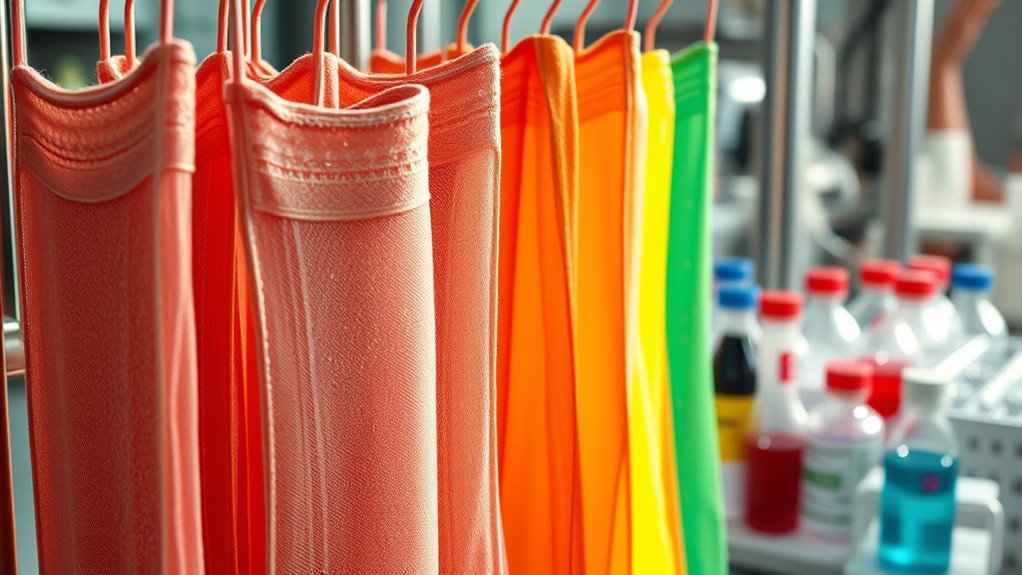If you’re sensitive to synthetic yarns in hosiery, you’ll want to know that fibers like polyester and nylon often contain chemical treatments, dyes, and finishes that can cause skin irritation or allergic reactions. Formaldehyde resins, heavy metal colorants, and fragrances are common culprits. Additives such as preservatives, stabilizers, and antimicrobials can also trigger issues. Understanding these irritants can help you choose safer options—keep going to discover how to minimize your exposure.
Key Takeaways
- Synthetic fibers like polyester and nylon may contain chemical residues or additives that cause skin irritation and allergies.
- Chemical finishes such as dyes, softeners, and anti-wrinkle agents can release formaldehyde or other irritants, triggering reactions.
- Formaldehyde resins and synthetic dyes may contain allergens or impurities that provoke skin sensitivities.
- Additives like preservatives, antimicrobial agents, and plasticizers in synthetic yarns can cause contact dermatitis and irritation.
- Choosing natural, organic, or hypoallergenic hosiery and washing before use reduces chemical residues and allergen exposure.
Synthetic Fibers and Their Allergic Potential

Have you ever wondered if the synthetic fibers in your hosiery could cause allergic reactions? Unlike natural fibers, which are breathable and less likely to trigger allergies, synthetic fibers like polyester and nylon can sometimes cause skin irritation. These fibers may contain chemical residues or additives that lead to allergic responses, especially if your skin is sensitive. To help with allergy prevention, look for hosiery made from natural fibers such as cotton or wool, which are generally gentler on your skin. Synthetic fibers tend to trap heat and moisture, aggravating skin issues for some people. If you notice itching or redness after wearing synthetic hosiery, switching to natural fiber options might reduce your risk of allergic reactions and improve comfort. Additionally, choosing fibers that allow better water drainage and breathability can help minimize skin irritation caused by trapped moisture.
Common Chemical Treatments in Hosiery Production

Many hosiery manufacturers treat fabrics with chemicals to enhance durability, appearance, and performance. These chemical treatments often include dyes, softeners, and anti-wrinkle agents. While synthetic fibers may often require such treatments, natural fibers offer benefits like breathability and hypoallergenic qualities, reducing the need for harsh chemicals. However, chemical treatments can still impact the environment, as they may involve toxic substances and waste runoff. When hosiery is finished with chemical agents, it can cause skin irritation for sensitive individuals, especially if synthetic yarns are involved. Being aware of these treatments helps you select products that align with your health and environmental values. Opting for hosiery with minimal chemical processing supports both skin comfort and eco-friendly practices. Additionally, understanding the chemical treatments in hosiery production can help consumers make more informed and healthier choices.
Formaldehyde Resins and Skin Sensitivity

You may not realize that formaldehyde resins are often used as preservatives in hosiery, which can cause skin reactions. Symptoms like redness, itching, and irritation might develop after wearing certain stockings. Luckily, safer alternatives are available to reduce your risk of sensitivity. Being aware of common irritants in synthetic yarns can help you make better choices for your skin health.
Formaldehyde as Preservative
Did you know that formaldehyde resins are commonly used in the production of hosiery to prevent wrinkles and extend shelf life? These resins act as preservatives but can cause skin sensitivities for some wearers. To reduce exposure, you might consider choosing hosiery made from natural fiber alternatives like cotton or bamboo, which typically contain fewer chemical treatments. Additionally, it’s worth considering environmental impact considerations, as formaldehyde resins are synthetic chemicals that can harm ecosystems during production and disposal. Opting for eco-friendly, minimally treated hosiery not only minimizes your skin’s contact with preservatives but also supports sustainability. Being aware of cookie types and their impact can help you make better choices regarding product ingredients and manufacturing processes. By understanding these factors, you can make more informed choices that benefit your skin and the environment.
Skin Reactions and Symptoms
Exposure to formaldehyde resins in hosiery can trigger skin reactions in sensitive individuals, leading to discomfort and irritation. You might notice symptoms like redness, itching, or a rash after wearing affected socks. These reactions are often signs of contact dermatitis caused by skin irritation from the allergen. Recognizing these signs early helps prevent worsening symptoms. Additionally, ongoing research into AI safety measures highlights the importance of monitoring and managing potential risks associated with chemical exposure.
Safer Alternatives Available
Fortunately, there are safer alternatives to traditional formaldehyde resins used in hosiery, which can help reduce skin sensitivities and allergic reactions. You can choose hosiery made from natural fiber alternatives like organic cotton, bamboo, or hemp, which don’t require harsh chemical finishes. These fibers are less likely to cause irritation and are more breathable. Additionally, look for products that use organic dye options, avoiding synthetic dyes that may contain irritants or allergens. Many brands now prioritize eco-friendly and hypoallergenic materials, making it easier for you to find hosiery suitable for sensitive skin. Chemical-free processes are also increasingly employed in textile manufacturing to minimize chemical residues. By opting for these safer alternatives, you support healthier skin and minimize your exposure to potentially harmful chemicals in traditional hosiery.
Dyes and Colorants That May Cause Reactions

Certain dyes and colorants used in hosiery can trigger allergic reactions in sensitive individuals. Both natural dyes and synthetic pigments may contain allergens that cause skin irritation or contact dermatitis. You should watch out for:
- Synthetic pigments derived from chemicals that may provoke sensitivities.
- Natural dyes like indigo or madder, which sometimes contain impurities causing reactions.
- Dyes with heavy metal residues, often found in cheaper or older hosiery.
- Unlabeled or poorly labeled hosiery that might hide harmful colorants.
- The processing methods used during manufacturing can also influence the likelihood of irritation, especially if harsh chemicals are involved.
Finishing Agents and Their Impact on Sensitive Skin

Finishing agents are chemicals applied to hosiery after weaving to improve appearance, texture, and durability. While effective, these agents can sometimes cause skin irritation, especially for sensitive skin types. Some finishing agents contain formaldehyde-releasing compounds or chemical resins that may trigger allergic reactions or discomfort. If you have sensitive skin, you might notice redness, itching, or rash after wearing new hosiery. Manufacturers often use finishing agents to make fabrics smoother or more resistant to wrinkles, but these chemicals can linger on the surface. To reduce irritation risks, look for hosiery labeled as free from harmful finishing agents or those made with natural or organic finishes. Washing new hosiery before wearing can also help remove residual chemicals and minimize skin reactions.
Microplastics and Irritation Risks

Many hosiery products contain microplastics—tiny synthetic fibers shed during wear and washing—that can pose irritation risks. When these microplastics enter your body through microplastics ingestion, they may cause skin irritation or discomfort. Additionally, these fibers contribute to environmental microplastic pollution, impacting ecosystems. To reduce exposure, consider these points:
- Limit frequent washing of synthetic hosiery to decrease fiber shedding.
- Use filters or laundry bags designed to catch microplastics.
- Opt for natural fiber alternatives when possible.
- Be aware of the potential for microplastic contamination in the environment.
- Regularly monitoring indoor air quality can help identify airborne microplastics and other pollutants that may affect health.
Preservatives and Additives in Synthetic Yarns

Many synthetic yarns contain preservatives and additives to improve durability and prevent microbial growth. These chemicals can include common preservatives and various additive types, each serving specific purposes. However, they may also trigger allergic reactions in sensitive individuals, so it’s important to be aware of their presence. For instance, some synthetic fibers may incorporate additive types to enhance performance, which can further contribute to allergen exposure.
Common Chemical Preservatives
Have you ever wondered what chemicals are added to synthetic yarns to boost their durability and shelf life? Chemical preservatives play a essential role in preventing microbial growth and deterioration. Here are four common types:
- Chemical stabilizers – They protect fibers from heat and UV damage, ensuring longevity.
- Dye fixatives – These chemicals help dyes bond securely, reducing fading and bleeding.
- Antimicrobial agents – They inhibit bacteria and fungi that cause odors and spoilage.
- Plasticizers – They improve flexibility and softness, making yarns more comfortable.
These preservatives often include chemical stabilizers and dye fixatives, which enhance performance while reducing the risk of allergenic reactions. However, some of these chemicals can cause irritation or allergic responses in sensitive individuals.
Additive Types and Roles
Ever wonder what types of additives are used in synthetic yarns to enhance their properties? These include preservatives, anti-static agents, color stabilizers, and flame retardants. Additives improve durability, appearance, and safety but can also cause fiber cross reactivity, leading to allergic reactions. Understanding additive interactions is key, as some compounds may amplify irritation or react unpredictably. Here’s a quick overview:
| Additive Type | Role |
|---|---|
| Preservatives | Prevent microbial growth during manufacturing |
| Anti-static agents | Reduce static build-up, improve comfort |
| Color stabilizers | Maintain color integrity over time |
| Flame retardants | Increase fire resistance, safety |
Knowing these helps you identify potential irritants and avoid allergic reactions linked to specific additive interactions. Recognizing the importance of tableware in social settings can also help you understand how materials and additives play a role in everyday life.
Potential Allergic Reactions
Synthetic yarns often contain additives like preservatives, anti-static agents, color stabilizers, and flame retardants to enhance their performance and safety. These chemicals can trigger allergic reactions, especially if your skin is sensitive. You might notice symptoms such as redness, itching, or irritation after wearing hosiery with these substances.
Potential allergic reactions include:
- Contact dermatitis caused by preservative residues
- Skin irritation from anti-static agents disrupting fabric weave comfort
- Allergic responses to color stabilizers affecting textile durability
- Sensitivity to flame retardants impacting overall fabric safety
Being aware of these additives helps you select hosiery that minimizes allergic risks. Always check labels and choose products designed to be hypoallergenic to ensure comfort and skin health.
Fragrance Components and Allergic Responses

Fragrance components in hosiery can trigger allergic responses in sensitive individuals, leading to skin irritation or contact dermatitis. Many synthetic yarns are treated with fragrances to add scent, but these fragrances can contain chemicals that cause allergic responses. When you wear scented hosiery, your skin may react with redness, itching, or swelling if you’re allergic. Fragrance components like limonene, linalool, or synthetic musk are common culprits. These substances can penetrate the skin and provoke immune reactions in allergy-prone people. If you notice irritation after wearing scented hosiery, it’s likely due to these fragrance components. To minimize risk, opt for unscented products or those labeled hypoallergenic. Recognizing the link between fragrance components and allergic responses helps you make safer choices for sensitive skin.
How to Identify and Avoid Harmful Synthetic Components

To effectively identify and avoid harmful synthetic components in hosiery, it’s important to read product labels carefully. Look for labels that specify natural fibers like cotton, wool, or silk, which offer benefits such as breathability and reduced irritation. Avoid items with vague synthetic fiber names like polyester or nylon without further information, as these can cause allergic reactions. Here are four tips to help you:
- Check for natural fiber content on labels.
- Research brands that prioritize eco-friendly and sustainable manufacturing.
- Be cautious of blends with high synthetic fiber percentages, which increase environmental impacts.
- Choose hosiery made from organic or recycled fibers to reduce both allergenic risk and environmental footprint.
This approach helps you stay comfortable and eco-conscious while minimizing allergen exposure.
Frequently Asked Questions
Can Synthetic Hosiery Cause Long-Term Skin Allergies?
Synthetic hosiery can cause long-term skin allergies if you’re exposed to chemical residues or dye sensitivities over time. These irritants may build up on your skin, leading to persistent reactions or sensitivities. If you notice ongoing irritation, it’s best to switch to natural fibers or look for hypoallergenic options. Being aware of chemical residues and dye sensitivities helps you prevent prolonged skin issues when wearing synthetic hosiery.
Are Natural Fiber Hosiery Safer Than Synthetic Options?
Choosing between natural fiber and synthetic hosiery is like weighing the pros and cons of different roads. Natural fibers are often gentler on your skin, reducing irritation risks, but they may lack the fiber durability of synthetics. Plus, natural options usually have a lower environmental impact, making them eco-friendlier. Ultimately, your choice depends on your skin sensitivity, longevity needs, and environmental values.
How Do I Test if I Have a Hosiery Allergy?
To check if you have a hosiery allergy, start with an allergy patch test from your dermatologist. They’ll apply small patches containing common allergens, including synthetic fibers, to your skin. You should leave the patches on for 48 hours and observe any reactions like redness or itching. If you notice symptoms, inform your doctor. This allergy patch test helps identify specific irritants causing your hosiery discomfort.
What Are the Signs of Contact Dermatitis From Hosiery?
When you experience contact dermatitis from hosiery, you’ll notice a rash appearance that’s red, inflamed, and sometimes blistered. You might also feel an itching sensation that worsens with contact or sweating. These signs typically show up on areas where the hosiery touches your skin. If you notice these symptoms after wearing tights or socks, it’s important to remove the irritant and consult a healthcare professional for proper diagnosis and treatment.
Are Hypoallergenic Synthetic Hosiery Options Available?
Did you know that up to 20% of people experience skin irritation from synthetic fibers? You’ll find hypoallergenic synthetic hosiery options now available, crafted from hypoallergenic materials designed to minimize irritation. These options offer the benefits of synthetic fibers—durability, stretch, and affordability—while decreasing allergen exposure. Choosing hypoallergenic synthetic hosiery helps protect sensitive skin, so you can enjoy comfort without worry. Always check labels to ensure they specify hypoallergenic or skin-friendly materials.
Conclusion
By understanding the common irritants in synthetic yarns, you can make smarter choices. Recognize the signs of irritation, avoid harsh chemicals, and choose hosiery made with gentle, natural alternatives. Stay informed, read labels carefully, and prioritize your skin’s health. Protect your skin from allergens, prevent reactions, and enjoy comfortable, irritation-free wear every day. Your awareness empowers you to select hosiery that’s safe, soothing, and suited to your sensitive skin needs.









